Employee Engagement Suffers from Outdated Beliefs
Engaged employees are a critical ingredient to any organization’s success. When they’re engaged, employees are more likely to go above and beyond what’s required of them, less likely to think about looking for a new job, and more likely to recommend the company as a great place to work. Despite the clear value, companies aren’t yet mastering employee experience (EX) management in a way that results in engaged employees.1
The concept of employee experience has evolved from a focus on “satisfaction” to a holistic view across the collection of interactions and experiences an employee has with an organization and their impact on employees’ daily lives. The cumulative effect of an employee’s experiences shapes their engagement at work. So, what’s inhibiting EX excellence? We believe that a significant part of the problem stems from an outdated set of beliefs around what “employee experience” is, which show up in statements like these:
- “Focusing on employee experience is about conducting surveys.” While gathering employee feedback is valuable, improved employee engagement comes from using those insights to improve the experiences that matter most to employees. This requires building the capacity and ability across the entire organization – from leader to individual contributor – to systematically understand and act on employee feedback.
- “What today’s employees want is ‘fun and free food.’” Making the workplace enjoyable by adding fun things outside of work activities – such as pizza parties or company sports teams – are nice to do, but they are insufficient to drive success. Employees aren’t engaged by having fun, they’re only engaged when they feel deeply connected with the organization’s goals.
- “Finding balance is the employee’s responsibility.” While technology and flexible work arrangements were initially thought to be the solution to work-life balance, in some organizations they have led to the exact opposite — an ‘always on’ expectation regardless of day or hour. Yet Qualtrics research has found that employees’ perceptions of their company’s support of work-life balance drive satisfaction, motivation, and intent to stay at the organization.2
- “It’s HR’s job to handle employee engagement.” Human Resources (HR) is an important department to help catalyze a company’s employee experience. But Qualtrics’ research with clients’ workforces shows that the most impactful changes happen within an employee’s team, not HR. On a day-to-day basis, every people manager across the organization is a critical component for increasing or decreasing their employees’ engagement.
Three Mindset Shifts for Employee Experience Success
To understand how companies can break through these outdated beliefs, we interviewed a number of organizations about their employee experience efforts. Our research uncovered three mindset shifts that companies need to make in order to gain the benefits of an engaged workforce 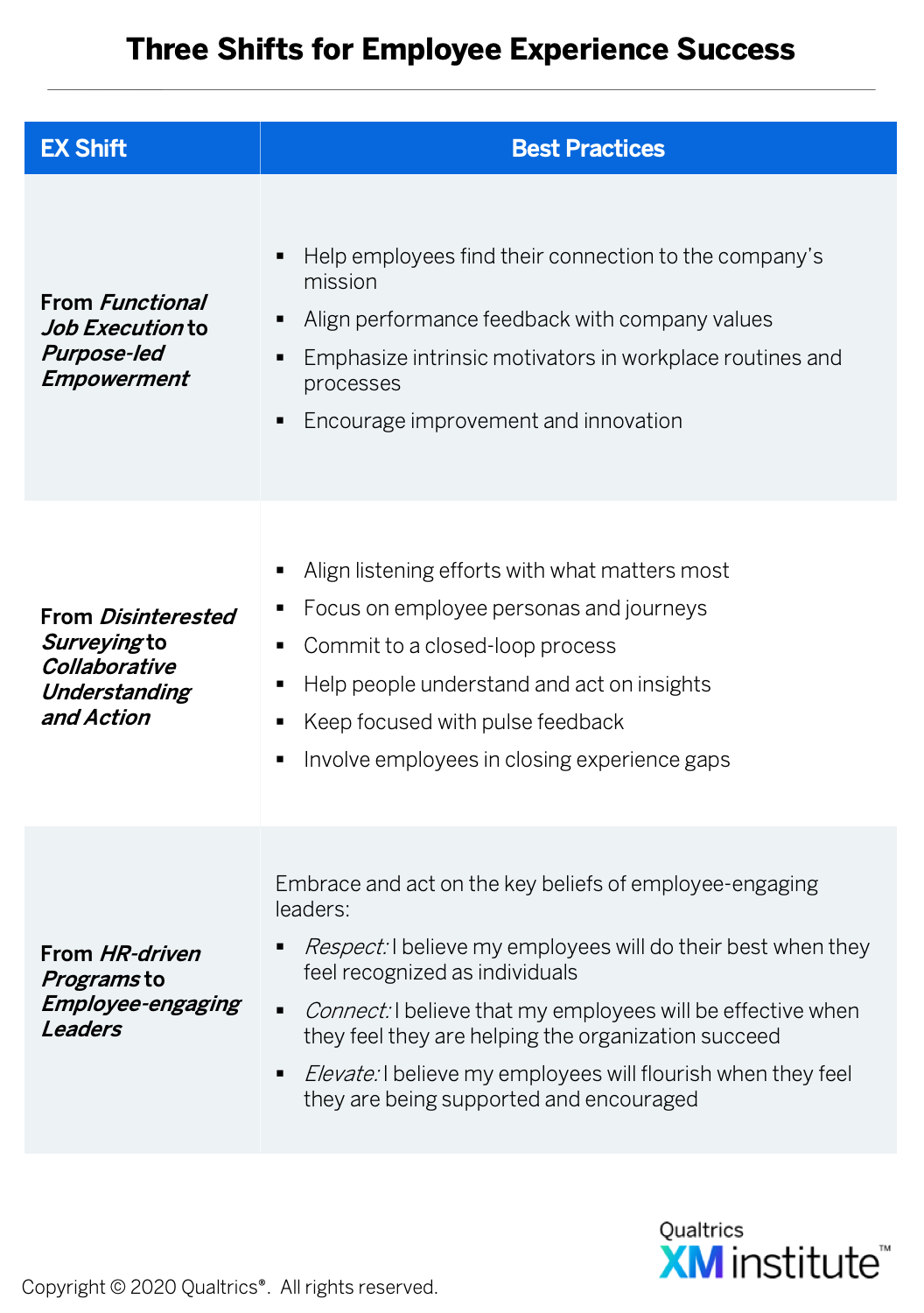 :
:
- From functional job execution to purpose-led empowerment. Rather than expecting uninspired compliance to narrow job descriptions, leaders must recognize empowered employees as a critical enabler of company strategy and success and invest in strengthening the connection of employees to the mission of the organization.
- From disinterested surveying to collaborative understanding and action. Companies must shift from periodically measuring and reporting on employee satisfaction or engagement to seeking out candid and actionable insights that enable conversations between managers and people across the moments that matter to them.
- From HR-driven programs to employee-engaging leaders. The individuals who lead people and teams must recognize the benefits of and be ready to fulfill their personal responsibility to engage employees every day instead of relying on the periodic motions of HR programs.
Future Mindset #1: Purpose-Led Empowerment
XM Institute research found that making a positive impact at work was the most important characteristic to employees, by a three-to-one margin over the next most selected option.3 So rather than constraining employees to fulfilling narrowly defined job descriptions, companies should empower employees by establishing strong alignment to the company’s purpose and creating opportunities for them to pursue their intrinsic motivations on the job. To do this companies should:
- Help employees find their connection to the company’s mission. Companies typically write job descriptions that focus on “what” the employee is required to do, with little to no discussion of why it’s important or how the role supports the company’s mission. Yet seeing a clear link between their work and the company’s strategic objectives is one of the top drivers of employee engagement and retention according to Qualtrics’ EX research.4 Companies should explicitly describe how the employee’s role contributes to the company’s goals. When a UK-based financial services company rolled out its long-term vision, it dedicated a day to introducing the vision to employees and distributed a vision booklet that included four personal questions for all employees to answer. Everyone was invited to share their responses on a “Vision Wall.” The company even went a step farther by challenging employees to work in teams to create their own viral video to communicate the vision, and provided cameras, storyboards and access to props and talent, such as look-a-like actors and singers and dancers. At the end of the roll-out, 89% of employees responded that they knew how they could contribute to the vision.5
- Align performance feedback with company values. Companies committed to an engaging workplace should look at how their values are woven through their entire performance management system. A home health services company uses its core values – admire people, WOW customer experience, find a better way, and passionate about making a difference – to support its mission and inform the company’s entire decision-making process. This includes choosing to flatten the organization structure to get employees closer to customers and improve implementation of customer-facing solutions. It has also eliminated annual performance reviews in favor of in-the-moment feedback referred to as “Bold Kindness.” To get this feedback system in place, the company holds workshops, provides education tools, and encourages team members to give feedback to each other “with care.” As a result, the leadership team has found it is driving improvements to employee and customer experiences at a much faster rate.6 A global property management organization, whose strategic priorities include a dedication to world-class customer experience, has implemented a digital peer-to-peer feedback program that empowers employees to recognize coworkers when caught in the act of delivering exceptional customer service. The program, called “Taking Ownership,” allows any employee to initiate a simple workflow process in one to two minutes which captures the feedback and triggers an award of either $100 or an extra day of vacation to the recognized employee.7
- Emphasize intrinsic motivators in workplace routines and processes. The cornerstone of encouraging employee productivity and contribution has long been extrinsic rewards like incentives and prizes. Yet it is an individual’s ability to tap into his or her intrinsic motivations – finding meaning, exercising choice, building competence, and achieving progress – that research shows bring out a greater commitment on the job. A debt settlement company trains contact center employees on behavioral styles so they can understand their own style and identify the style of customers and fellow employees. As a result, rather than having to adhere to scripts during customer interactions, employees have greater autonomy in how they choose to adapt their communication style to what would work best based on the situation. The company has found that offering employees more choice has led to higher trust relationships both internally and with clients. To help employees who want to grow and progress into new or higher roles in the organization, a US-based bank offers a career path tool within its learning and development program. With this tool, employees can independently manage their career from end-to-end, identify their knowledge and skill learning goals, connect their skills to future roles, and proactively develop their plan to advance at the bank.
- Encourage improvement and innovation. When a company aligns its employees to its mission and purpose, it inspires them to look for ways to make their work and the company better. A core value of a home healthcare company is Find a Better Way and it uses this value to promote an entrepreneurial culture and individual initiative among employees. Its “Self-Led Award” encourages team members to find solutions to company or customer problems and share them with the organization. On a quarterly basis, the leadership team reviews submissions and the winners receive a trophy and lunch with a member of the leadership team.8 An auto and home insurer supports company-wide product, process, and experience improvements by involving its employees in innovation challenges. Employees can suggest, rate, and develop solutions to problems or opportunities posed by different departments. To support this effort, it has trained all of its employees on how to use design thinking techniques and established an “Innovation Hub” – its online portal where employees can access design thinking resources and an idea management platform.9
Future Mindset #2: Collaborative Understanding and Action
According to XM Institute’s Q4 2019 survey of HR executives at large organizations, 66% of respondents report that executive teams at their companies place a high priority on acting on feedback from employee engagement studies. Yet when employees were asked to weigh in, only 35% of them indicated their company performs ‘very’ or ‘extremely well’ at turning their feedback into action.10 With two in three employees believing it’s very important for their employers to listen to their feedback, companies need to shift from employee feedback systems that result in minimal improvements to a collaborative process with employees that identifies and closes critical experience gaps.11 They can do this when they:
- Align listening efforts with what matters most. A strong employee feedback program monitors the employee experience with the right mix of listening channels for identifying and prioritizing areas of improvement
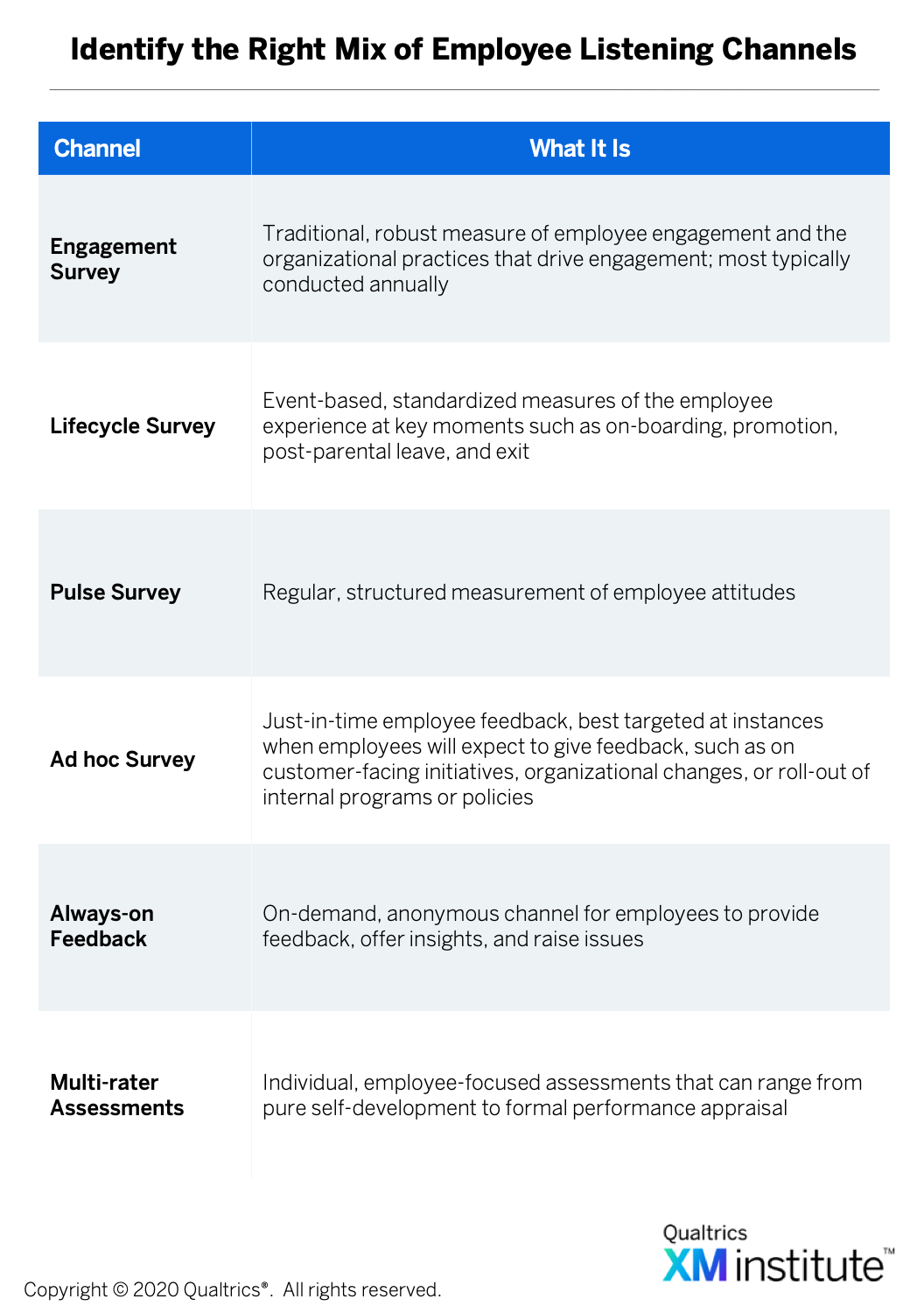 . One healthcare organization was suffering from higher-than-desired employee turnover following a period of accelerated growth. To better diagnose what employee experience gaps it needed to close, the company introduced an annual engagement survey combined with surveys during the onboarding and exit journeys of employees. With this feedback it was able to address issues specifically impacting new hires that were causing them to leave and prioritize the right actions to retain employees across the enterprise. To get a better understanding of how important company news was being received by employees, one software technology company integrated an on-demand listening post into the broadcasts of its company townhalls. While the distributed, virtual nature of the event previously had made it difficult to gauge employees’ perceptions and sentiment of critical company announcements, this new feedback channel combined quick ratings with open-ended feedback to understand what resonated with employees and where different information needed to be shared.
. One healthcare organization was suffering from higher-than-desired employee turnover following a period of accelerated growth. To better diagnose what employee experience gaps it needed to close, the company introduced an annual engagement survey combined with surveys during the onboarding and exit journeys of employees. With this feedback it was able to address issues specifically impacting new hires that were causing them to leave and prioritize the right actions to retain employees across the enterprise. To get a better understanding of how important company news was being received by employees, one software technology company integrated an on-demand listening post into the broadcasts of its company townhalls. While the distributed, virtual nature of the event previously had made it difficult to gauge employees’ perceptions and sentiment of critical company announcements, this new feedback channel combined quick ratings with open-ended feedback to understand what resonated with employees and where different information needed to be shared. - Focus on employee personas and journeys. Employees bring their own unique needs and objectives to work and are in varying stages in their personal and professional lives. Despite this variety, companies often seek to understand employees through “one-size-fits-all” feedback programs that, at best, are analyzing feedback by department, or job classifications. To drive more actionable insights, companies should instead examine feedback by employee personas and journeys tapping into a combination of experience data (X-data) and operational data (O-data). To understand the strengths and weaknesses of its new hire onboarding process, an HR team at a public accounting firm personalizes survey questions (X-data) and separated feedback by different persona types such as a new college graduate, an experienced hire with 10+ years of job history, and an employee joining the company through acquisition (O-data). When revamping its approach to training and development offerings, the same firm analyzed feedback across three distinct employee learning journeys: an accountant who is new and learning the ropes, a CPA who is actively pursuing advanced certification, and a CPA who is new to managing people and the associated leadership and administrative responsibilities.
- Commit to a closed-loop process. Organizations whose employees feel they turn employee feedback into action ‘very’ or ‘extremely well’ have twice as many engaged employees compared to organizations that do a poor job at taking action.12 If companies really want to make progress on closing experience gaps, then everyone in the organization needs to adopt a distinct continuous listening and closed-loop process from one-to-one follow-up to strategic decision making
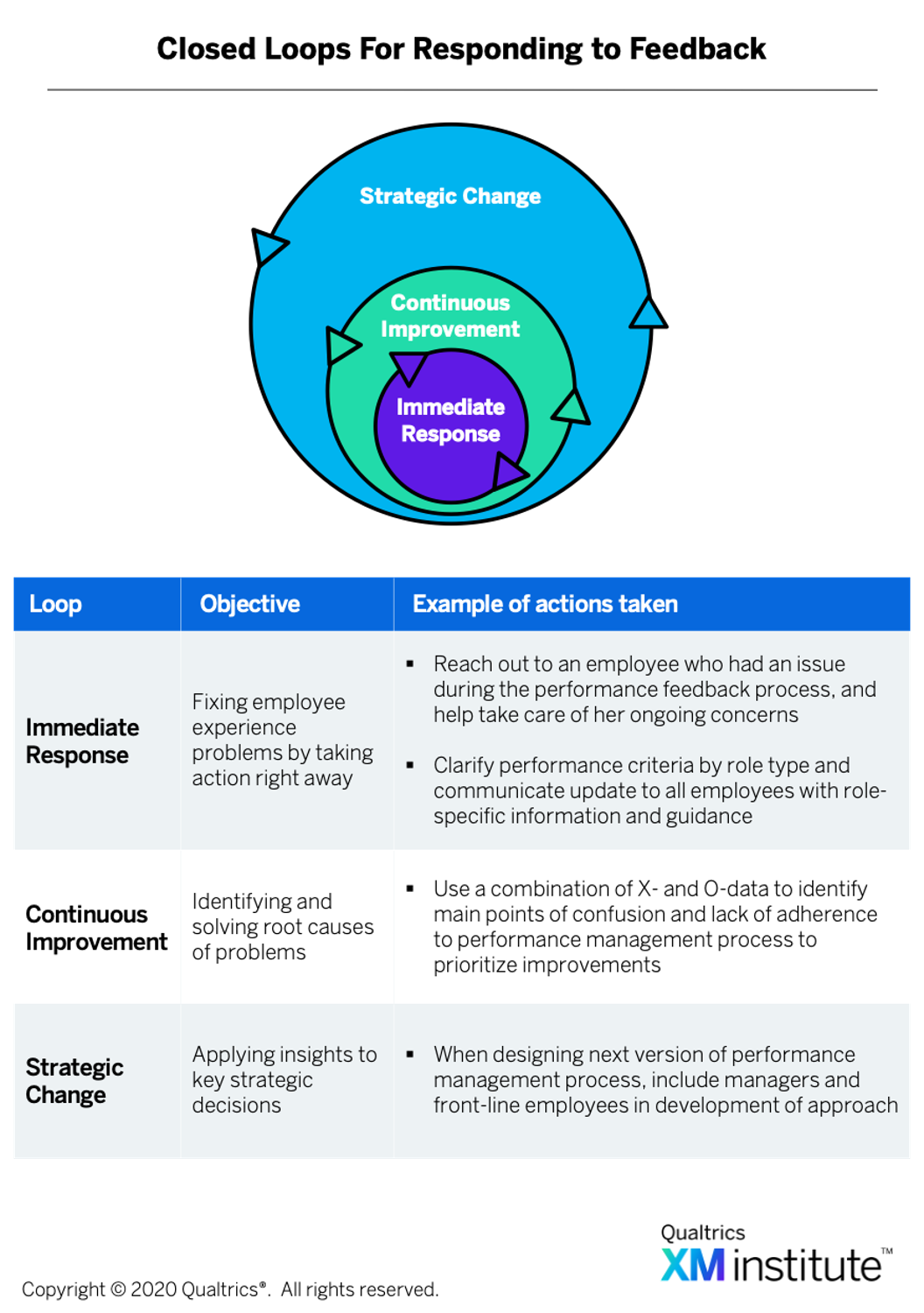 . To scale this across an organization, companies can leverage role-based dashboards and related tools to deliver insights and supporting information to individuals and managers to enable them to have effective conversations with each other on how to address experience gaps together
. To scale this across an organization, companies can leverage role-based dashboards and related tools to deliver insights and supporting information to individuals and managers to enable them to have effective conversations with each other on how to address experience gaps together 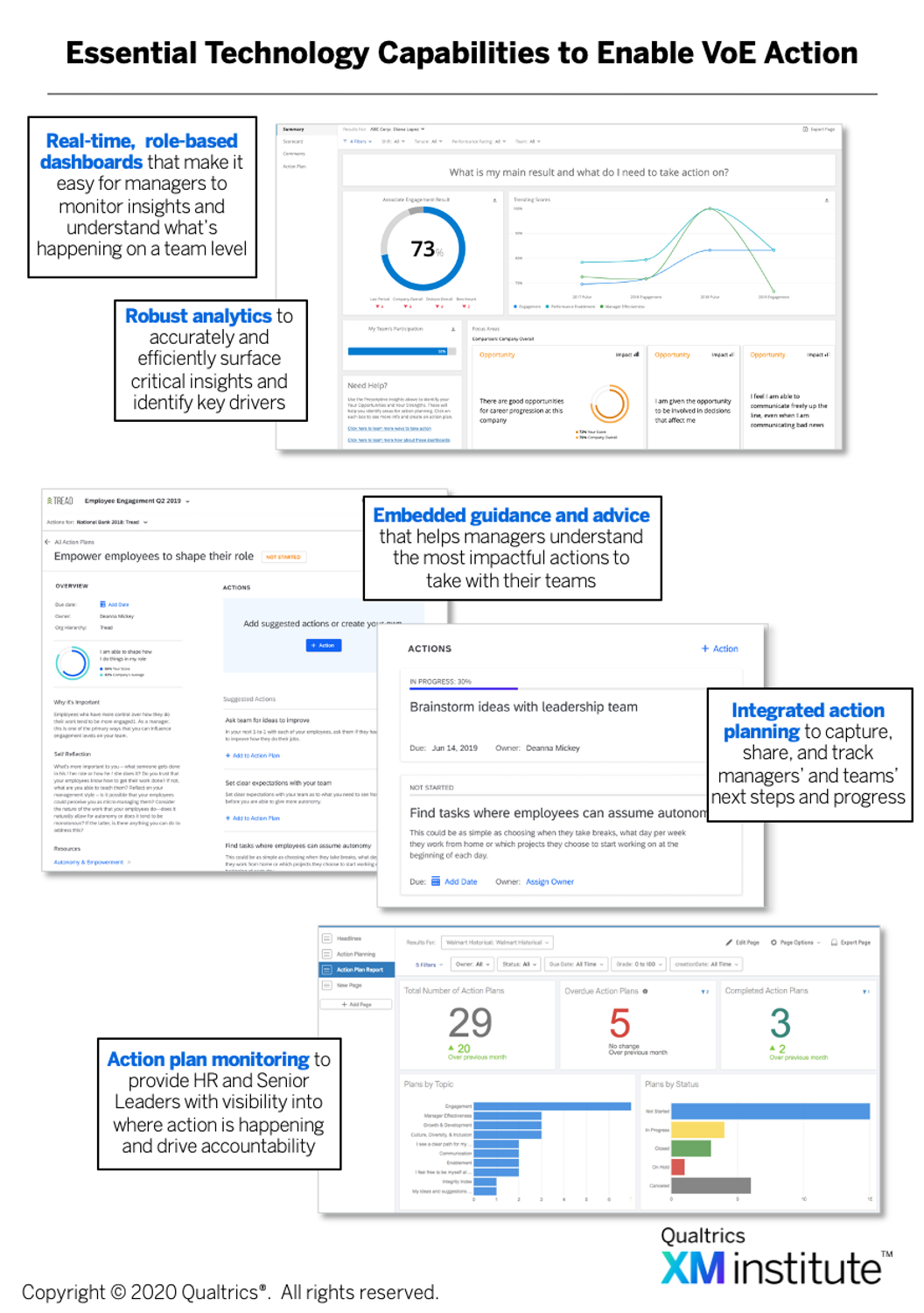 . Leaders and managers need tailored views of data that highlight key issues, allow for exploring patterns and trends, and include analytics that aid in prioritization of next actions. For employees, companies should work up to generating individual reports highlighting engagement drivers within their control, with links to resources that aid personal reflection and action on those drivers. One organization replaced the generic ‘Thank You’ page at the end of its annual survey with a simple summary of what the employee said in the survey along with some personal self-reflection questions based on Marshall Goldsmith’s daily questions, such as “Could I have done something different to improve my interactions with my coworkers today?” To ensure that the closed-loop process is completed, and to make it easy for managers and employees to keep track of company, team, and individual actions, a shared system of record for creating, reviewing, updating, and reporting on action plans is essential. Intelligent systems that can include embedded recommendations of actions and next steps based on insights help infuse best practice approaches and consistency across the enterprise.
. Leaders and managers need tailored views of data that highlight key issues, allow for exploring patterns and trends, and include analytics that aid in prioritization of next actions. For employees, companies should work up to generating individual reports highlighting engagement drivers within their control, with links to resources that aid personal reflection and action on those drivers. One organization replaced the generic ‘Thank You’ page at the end of its annual survey with a simple summary of what the employee said in the survey along with some personal self-reflection questions based on Marshall Goldsmith’s daily questions, such as “Could I have done something different to improve my interactions with my coworkers today?” To ensure that the closed-loop process is completed, and to make it easy for managers and employees to keep track of company, team, and individual actions, a shared system of record for creating, reviewing, updating, and reporting on action plans is essential. Intelligent systems that can include embedded recommendations of actions and next steps based on insights help infuse best practice approaches and consistency across the enterprise. - Help people understand and act on insights. Even when organizations analyze feedback and distribute insights, managers and employees don’t automatically know what to do with the information. EX teams need to invest the time to educate managers on how to interpret and use the insights that are shared with them, suggest ways to incorporate follow-up into managers’ daily routines with their teams, and provide easy-to-implement guidelines to have action planning discussions with individuals and teams. One technology company embedded advice directly into managers’ new feedback dashboards, providing one-click access to short tips and micro-training sessions that explained what each particular section of feedback meant. This online support was supplemented by coaching from HR business partners who spent dedicated time helping managers strategize team and 1:1 action planning discussions. A healthcare staffing organization includes a course in its new manager training curriculum specifically focused on reinforcing the importance of employee engagement and retention. The program teaches strategies for front-line managers to deploy as part of their daily routines, including emphasizing how to use formal and informal sources of employee feedback to identify key talking points for daily lineup meetings with their staff. Similarly, individual contributors should get the information and coaching they need to understand how their feedback will be used, what to expect from their manager, what’s expected of them individually, and how to find and use the information that will be made available to them.
- Keep focused with pulse feedback. While investments in annual engagement surveys and lifecycle surveys targeted at key moments in an employee experience are a great start, a gap remains when it comes to monitoring EX opportunities that are shifting every day. As an EX program matures, incorporating a program of pulse surveys can provide an ongoing view into meaningful changes in employee experiences, enabling the organization to react with immediacy when required. This listening method can be useful in adding agility to the organization’s employee listening program but should only be deployed when the organization is ready for additional insights rather than being overburdened by them. One utility company introduced bi-monthly pulse surveys that measured key engagement drivers and solicited feedback on issues impeding employees’ on-the-job success. Using the insights gathered, the HR team was able to reprioritize one of its larger EX initiatives mid-year to address key drivers that were rising in importance, while also providing business leaders information to get ahead of emerging employee-reported obstacles. A consumer product company’s monthly employee pulse survey surfaced insights that helped supervisors clarify expectations and direction through on-going conversations with employees and to accelerate supervisors’ interventions with employees whose performance was lagging.
- Involve employees in closing experience gaps. Employee feedback programs can sometimes uncover more questions than answers, which company leaders then try to address by making assumptions on what things they should do to employees in order to make the workplace better. Companies are better served by having employees take an active role in improving their own experiences and include them in deeper diagnosis of identified issues and determining how they or the company should act. To bring employees into this effort, one financial services company convenes employee focus groups and uses ad hoc surveys when feedback about company culture indicates the need to learn more about what’s working and not working. HR partners consult with the specific business area that has a need for this employee “reconnect” and diagnosis effort, which can be triggered by culture trends from annual employee survey results, employee council discussions, or other employee- or customer-derived insights. A telecommunications company uses a formalized decision-making process that encourages all team members to exchange ideas and collaborate before taking action. Listening plays a key part across the five-step process – from answering team member questions and asking for input during the commitment step to brainstorming and debating options during the exploration step. When decisions are executed, employee feedback is used to make course corrections and to determine impact when evaluating overall results of the decision-making process and actions taken. The company has found that this process leads to higher quality and more effective decisions, a greater sense of personal responsibility among employees, and more positive overall sentiment about working for the company.
Future Mindset #3: Employee-Engaging Leaders
Organizations that want to deliver a sustainable, positive employee experience must realize that EX happens outside of the boundaries of HR processes. EX success is driven by the day-to-day activities of individual leaders and managers, who through incremental behavioral changes, can have a greater impact than major HR process or policy changes. In fact, Qualtrics’ global employee experience survey found that manager involvement in investing in employee career development and helping to manage work issues are top drivers of employee retention.13 To build this pervasive approach to EX across the organization, every people manager needs to embrace and act on a set of three beliefs that we describe as Respect, Connect, and Elevate 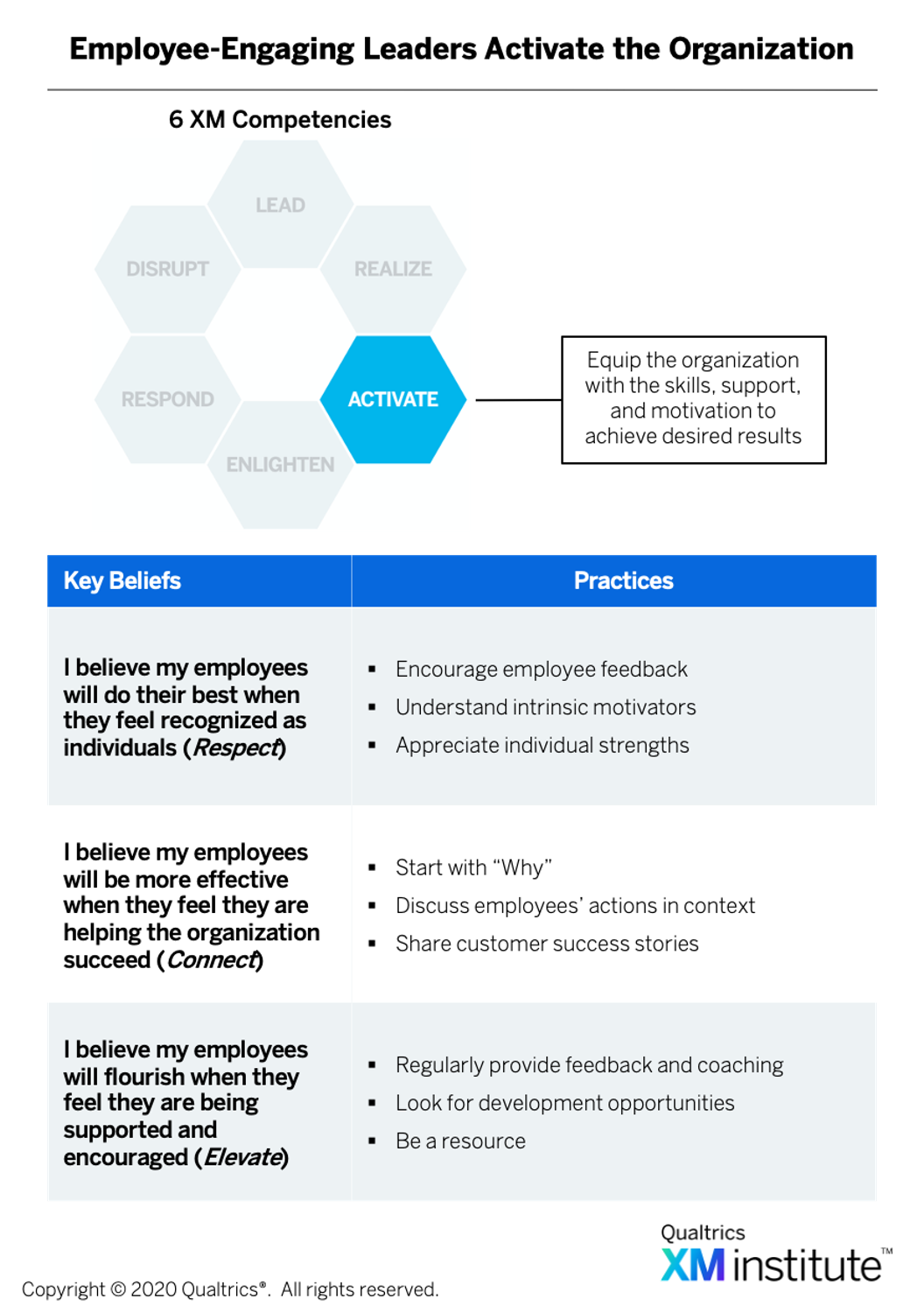 :
:
- Respect: I believe my employees will do their best when they feel recognized as individuals. When managers embrace this belief, they understand that people have different needs and desires, want their efforts to be appreciated and ideas to be heard, and have different strengths and weaknesses
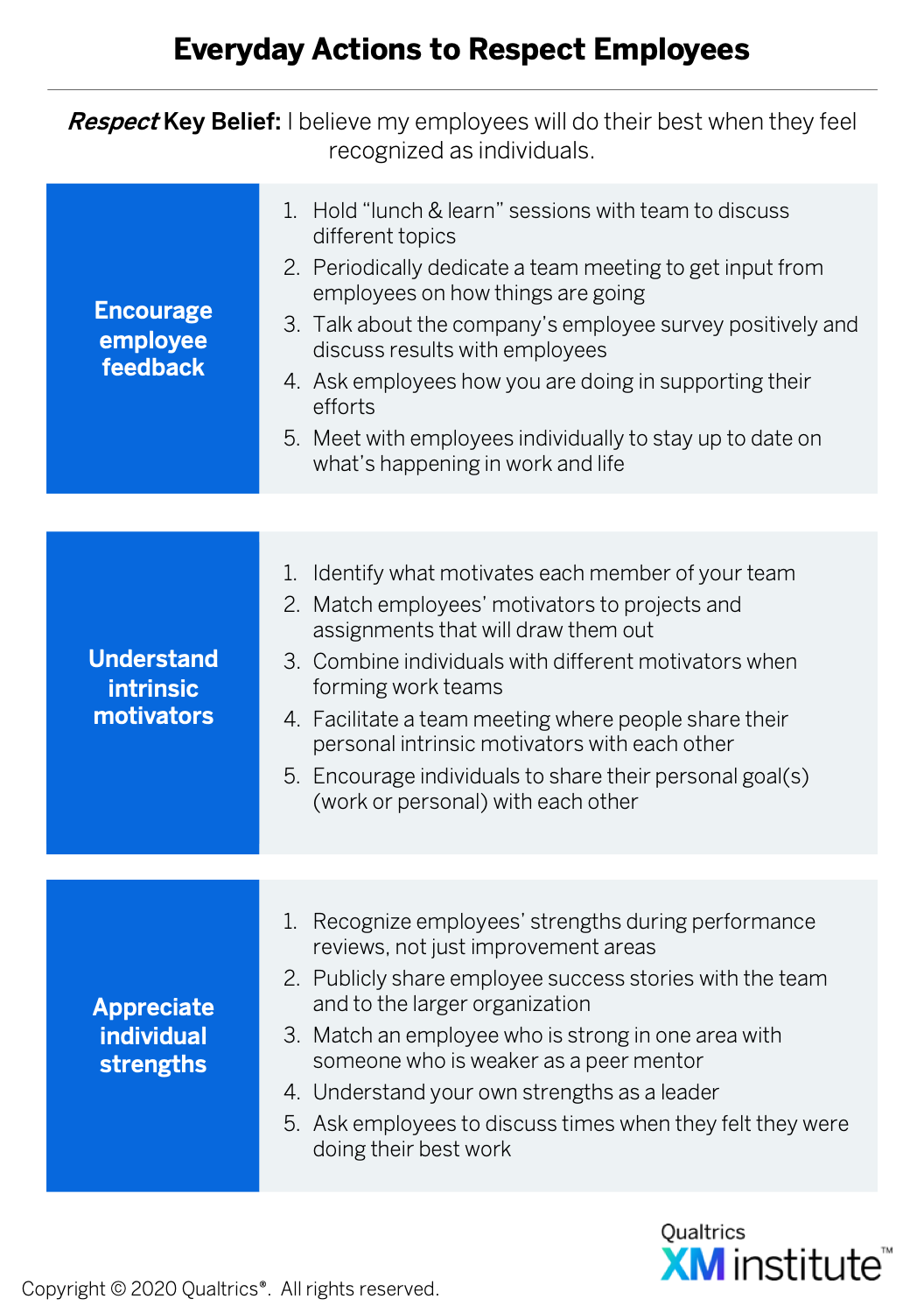 .
. - Connect: I believe my employees will be more effective when they feel they are helping the organization succeed. Connecting employees and their work to the team or company mission is the natural result of leaders understanding that people want to find meaning in their work, want to feel helpful, are more empowered when they understand the goals of their work, and want to see the results of their efforts
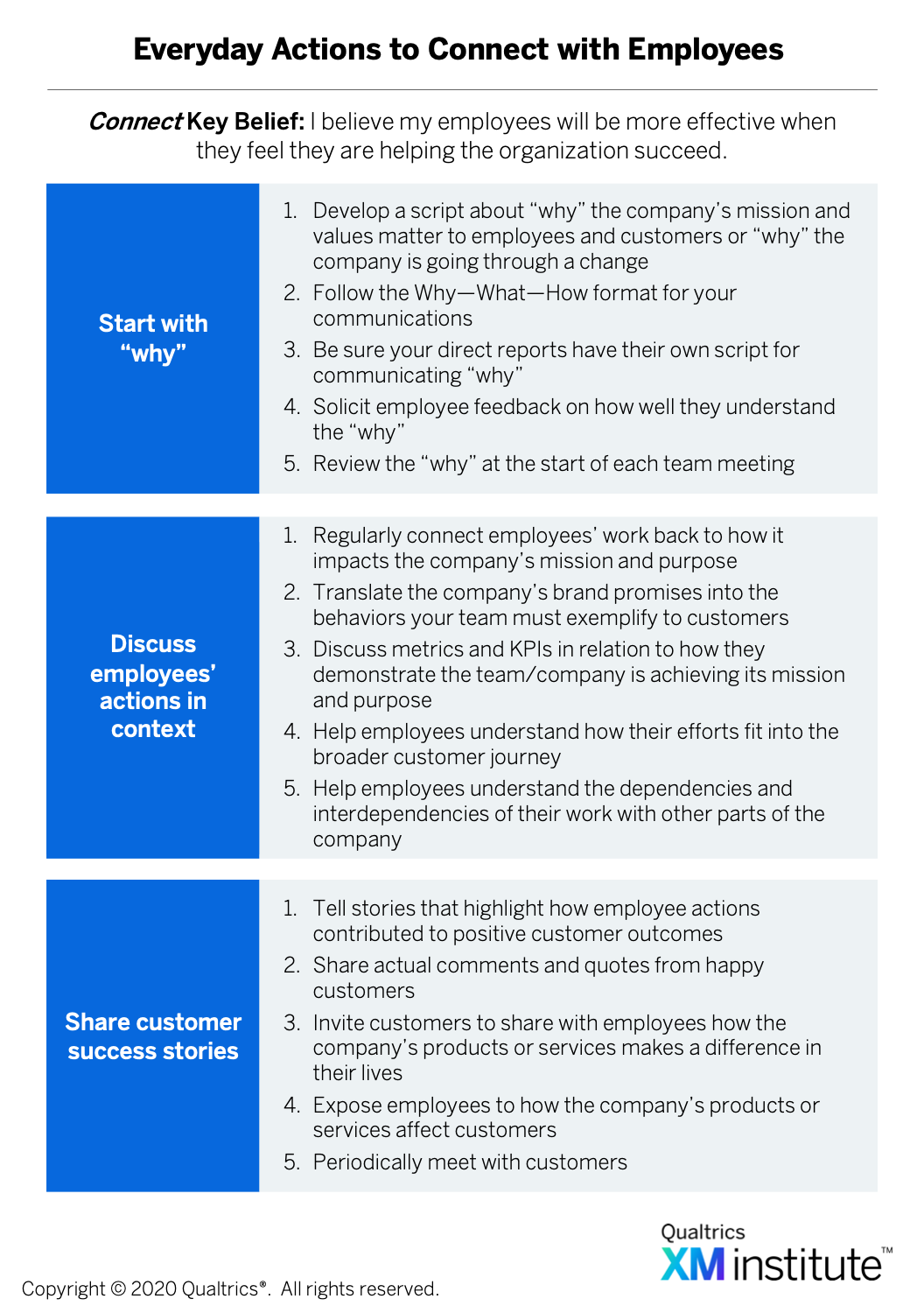 .
. - Elevate: I believe my employees will flourish when they feel they are being supported and encouraged. Helping employees reach their full potential is perhaps the most important and most challenging work employee-engaging leaders will do. It starts with understanding that while people want to know how they are doing and feel like they have an advocate on their side, sometimes they also need help uncovering opportunities, need to be encouraged to take risks, and don’t always ask for help when they need it
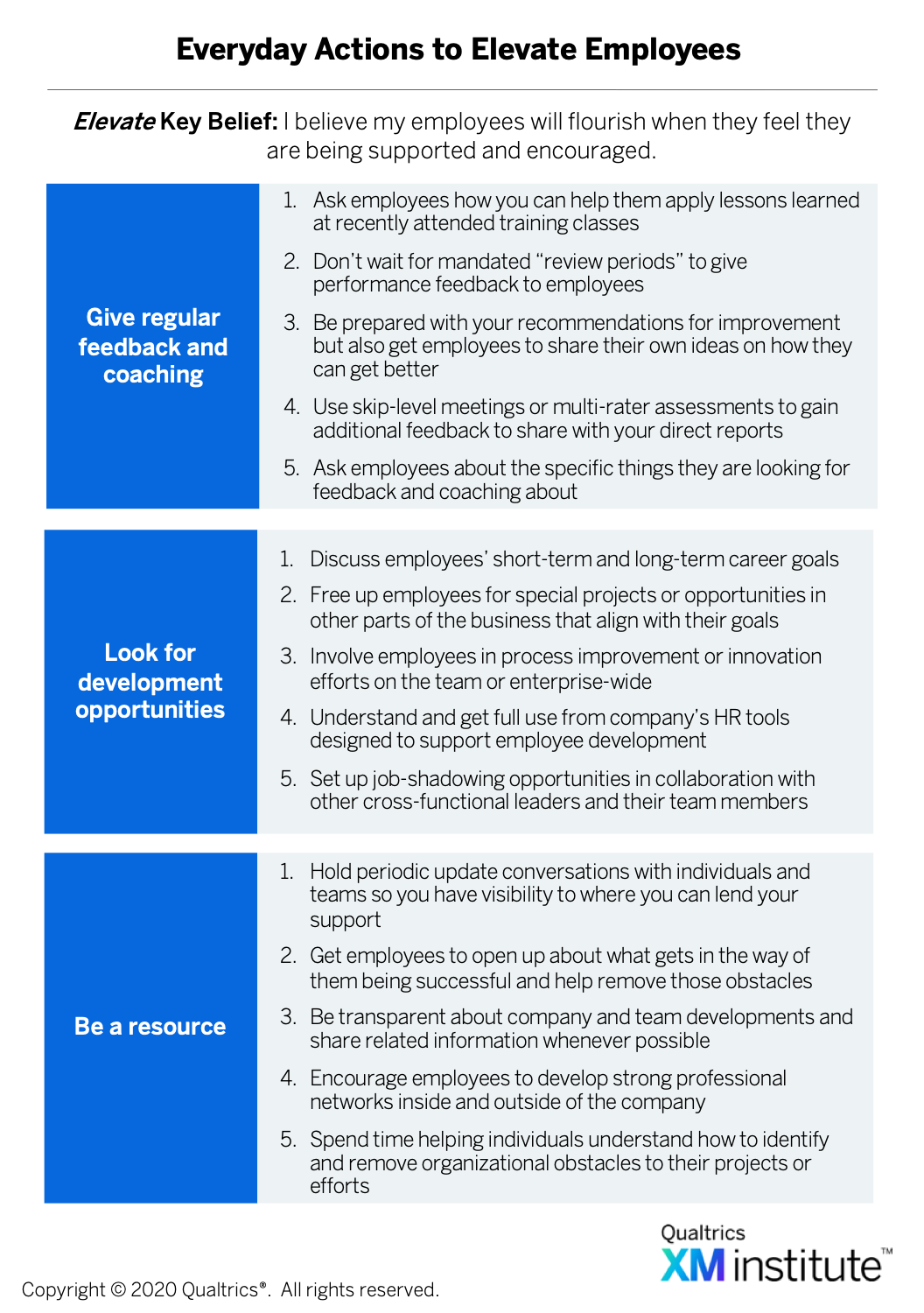 .
.
Implications of the Three Shifts Across the Employee Journey
All three of these shifts will help companies improve the effectiveness of their EX efforts. However, embracing these shifts across an organization will have an impact on and require tapping into the full capabilities of the XM Operating Framework and 6 XM Competencies 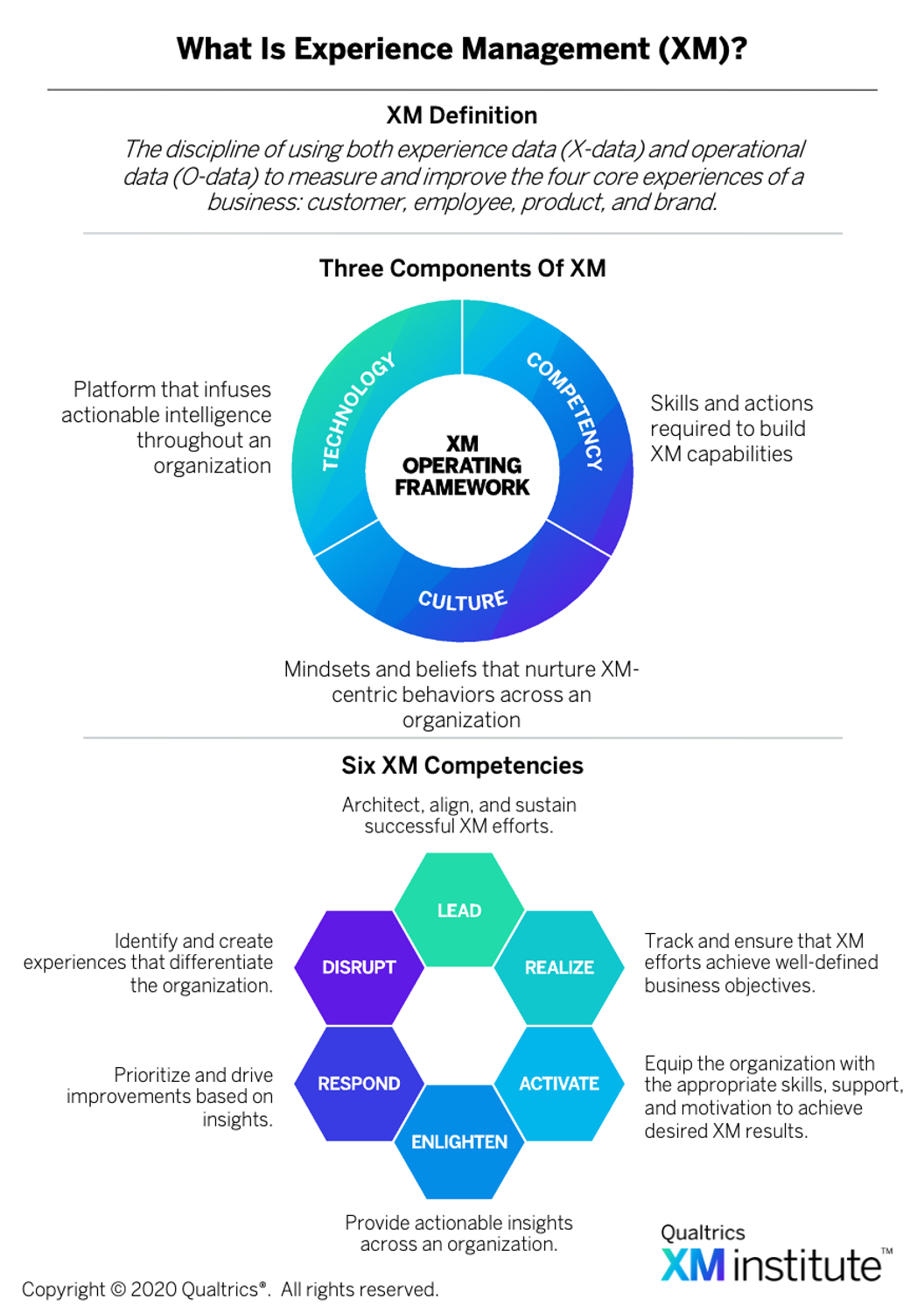 ,
, 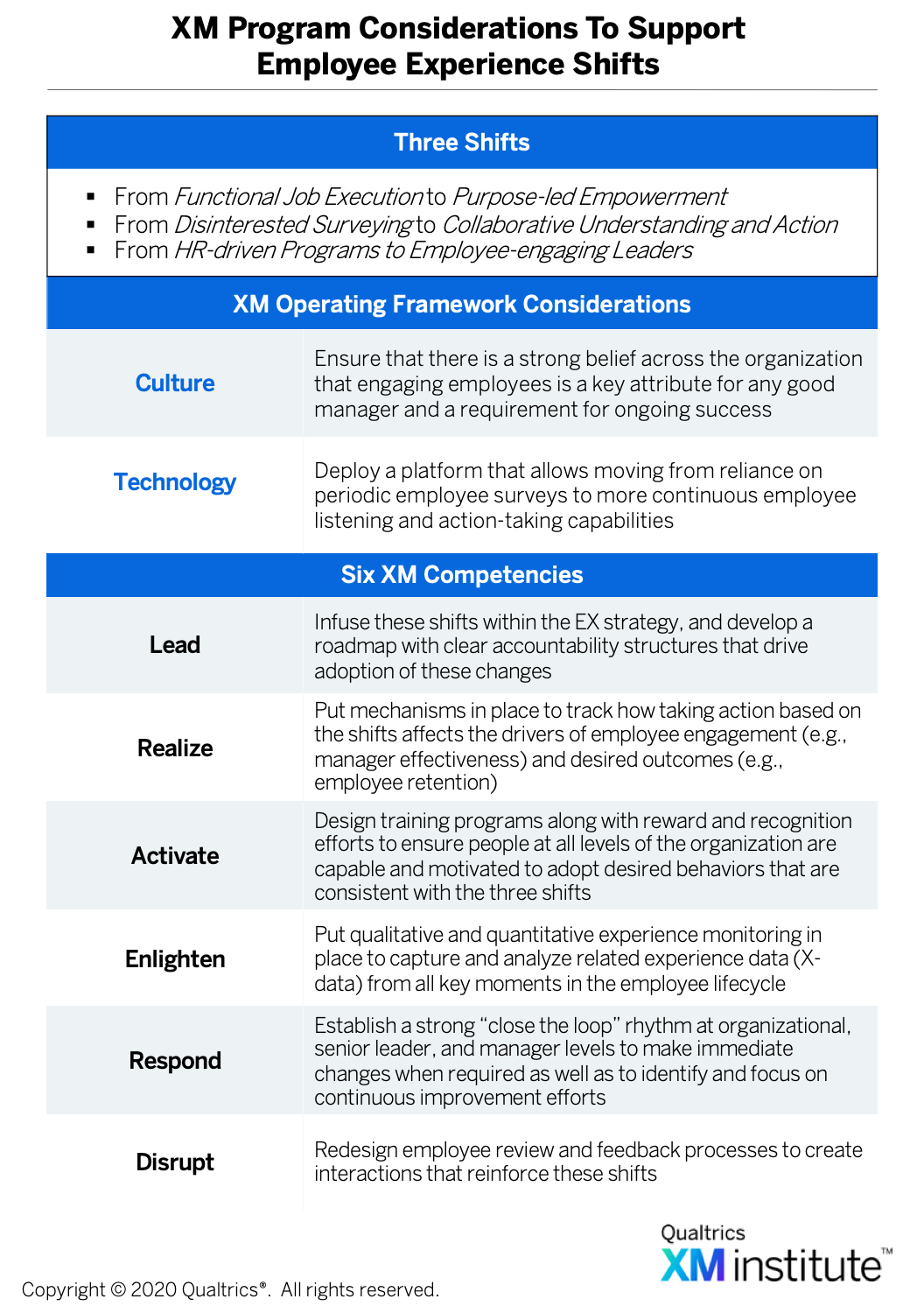 :
:
- Culture. In many organizations, adopting these three shifts will require a fundamentally different environment where new mindsets and behaviors will be able to take hold and thrive. It is culture that will ultimately accelerate or inhibit progress so it will be important both to create organization-wide intellectual understanding and buy-in to the shifts and to foster a belief that the new ways of working are truly valued by the organization’s senior leaders.
- Technology. Getting leaders, managers, and employees to embrace new processes and behaviors can be hindered when employee systems and tools support old ways of doing things. An organization can propel adoption and scale of these shifts with technology that integrates into daily workflows and delivers tailored guidance and behavioral nudges to employees at all levels.
- Competency. In many cases, these shifts will mean employees at all levels of the organization will need to build new skills that support the type of employee experience the company wants to deliver. This will mean capability-building across all six XM competencies: Lead, Realize, Activate, Enlighten, Respond, and Disrupt.
- We define Experience Management (XM) as the discipline of using experience data and operational data to measure and improve the core experiences of business: employee, customer, product, and brand. See XM Institute insight report, “Operationalizing XM” (July 2019).
- See Qualtrics research “State of Play: US Employee Engagement Trends, 2018”
- See “Employees Want to Make a Positive Impact,” Experience Matters blog, November 29, 2018.
- See “2020 Global Employee Experience Trends”
- See “How Capital One Drove Employee Engagement through Experimentation” accessed at https://peoplelab.co.uk/case-studies/capital-one/
- See XM Institute report, “Lessons in CX Excellence, 2018” (January 2018)
- Ibid.
- See XM Institute report, “Lessons in CX Excellence, 2018” (January 2018)
- See XM Institute report, “Propelling Experience Design Across an Organization” (April 2018)
- See Qualtrics research “2020 Global Employee Experience Trends”
- Ibid.
- See Qualtrics research “2020 Global Employee Experience Trends”
- See Qualtrics research “2020 Global Employee Experience Trends”





